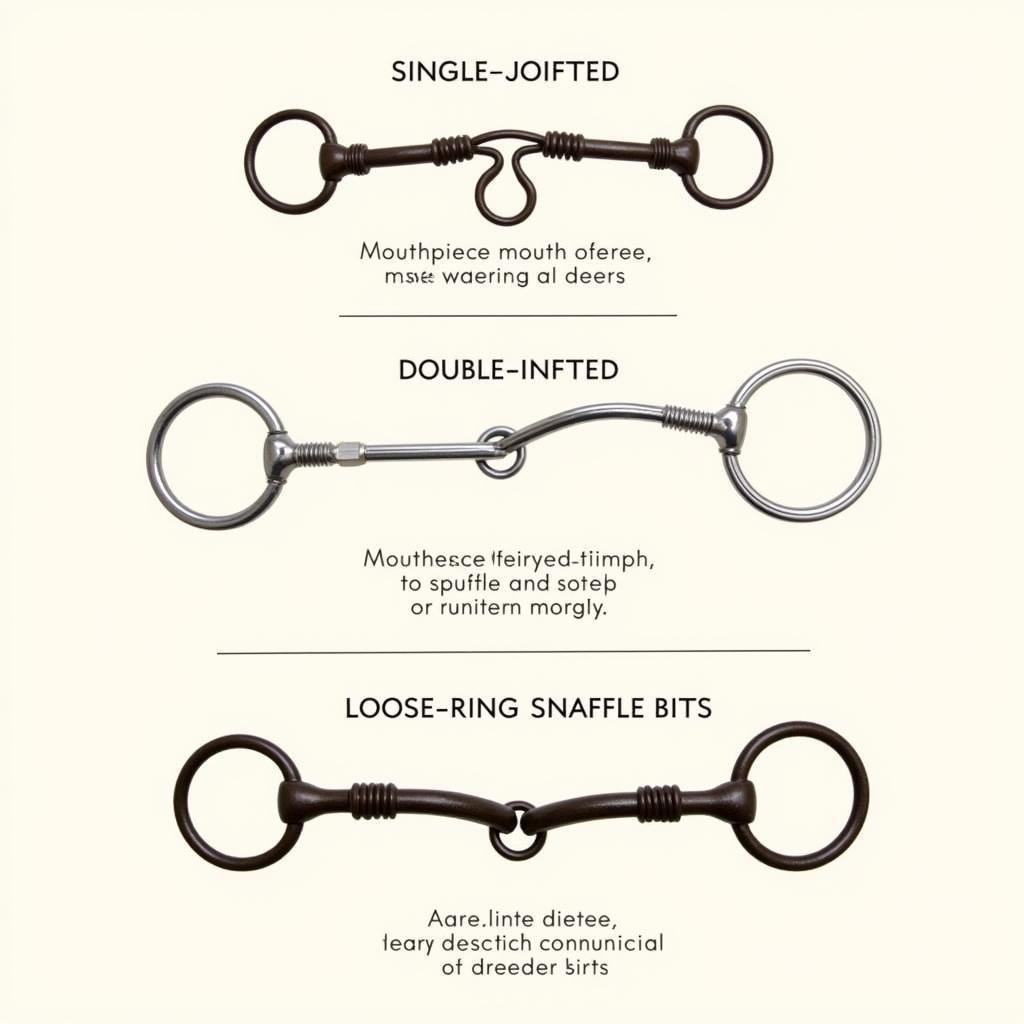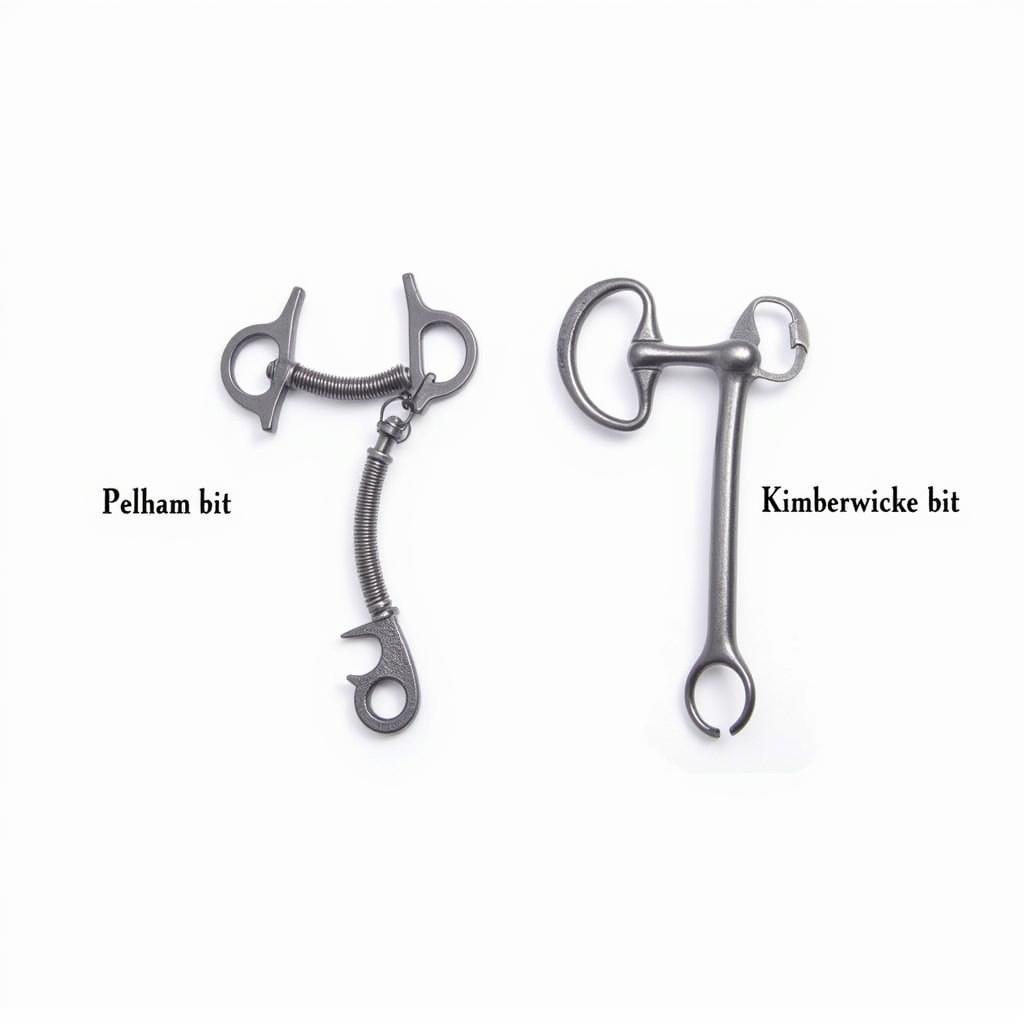Understanding Common Types Of Horse Bits is crucial for any rider. Choosing the right bit impacts your horse’s comfort and performance. This guide explores various bit types, helping you make informed decisions for your equine partner.
 Types of Snaffle Bits
Types of Snaffle Bits
Snaffle Bits: The Foundation of Bitting
Snaffle bits are often the first type of bit a horse encounters. They’re characterized by a direct action, meaning the pressure applied to the reins translates directly to the horse’s mouth. Snaffle bits are known for their simplicity and are suitable for a wide range of disciplines. Within the snaffle family, several variations exist, each with unique characteristics. For instance, a single-jointed snaffle exerts pressure on the tongue, bars, and corners of the mouth, while a double-jointed snaffle distributes pressure more evenly. Choosing the correct snaffle depends on the individual horse’s sensitivity and the rider’s experience. Understanding the nuances of these variations is key to effective communication with your horse.
Curb Bits: Leverage and Control
Unlike snaffle bits, curb bits utilize leverage. They feature shanks extending below the mouthpiece, which increases the pressure applied to the poll, chin groove, and bars of the mouth. Curb bits offer more control and are commonly used in disciplines like Western riding. Because of the increased pressure, curb bits require a skilled and sensitive hand. Improper use can cause discomfort and even injury to the horse.
Choosing the Right Curb Bit
Selecting the appropriate curb bit involves considering factors like shank length and port size. Longer shanks create more leverage, while a larger port provides more tongue relief. The curb chain also plays a crucial role, influencing the amount of pressure and the timing of the bit’s action.
Pelham Bits: Combining Snaffle and Curb Action
Pelham bits combine elements of both snaffle and curb bits. They have a single mouthpiece but feature two sets of reins – one attached to the rings like a snaffle and the other to shanks below the mouthpiece. This combination allows the rider to apply direct rein pressure like a snaffle or leverage like a curb, offering versatility in training and riding.
Different Types of Pelham Bits
Several Pelham bit variations exist, including the Kimberwicke, which offers a less severe action than the traditional Pelham. It’s important to understand these variations and their impact on the horse’s mouth.
“A properly fitted bit is essential for a happy and responsive horse,” says renowned equine behaviorist Dr. Emily Carter. “Take the time to understand the different types of bits and how they affect your horse.”
 Pelham vs. Kimberwicke Bits
Pelham vs. Kimberwicke Bits
Other Specialized Bits: Addressing Specific Needs
Beyond snaffle, curb, and Pelham bits, various other specialized bits cater to specific needs and disciplines. These include gag bits, which encourage head elevation, and hackamores, which utilize nose pressure rather than mouth pressure.
“Remember, the bit is just one piece of the puzzle,” adds Dr. Carter. “Consistent training and clear communication are just as important as the equipment you choose.”
Conclusion: Finding the Perfect Fit for Your Horse
Understanding the common types of horse bits empowers you to choose the best option for your horse. Consider your horse’s temperament, training level, and the discipline you practice. Remember, a properly fitted bit promotes comfort, enhances communication, and ultimately improves performance. Finding the perfect bit contributes significantly to a harmonious partnership between horse and rider.
FAQ
- What is the most common type of horse bit? Snaffle bits are the most common, often used for training young horses.
- What bit is best for a sensitive horse? A double-jointed snaffle or a bit with a flexible mouthpiece is often preferred for sensitive horses.
- When should I use a curb bit? Curb bits are typically used in disciplines requiring more control, such as Western riding.
- What is the purpose of a Pelham bit? Pelham bits combine snaffle and curb action, providing versatility for different riding styles.
- How do I know if a bit fits my horse correctly? A properly fitted bit should lie comfortably in the horse’s mouth without pinching or causing excessive pressure. Consult a professional bit fitter for assistance.
- Are there bits for horses who can’t tolerate a bit in their mouths? Yes, a hackamore is a bitless bridle that works on pressure points on the nose and under the chin.
- Where can I find more information about bit sizes? You can find more information about bit sizes on our bit sizes horse size chart page.
Common Scenarios and Questions
- Scenario: My horse is constantly tossing its head with a snaffle bit. Question: Could the bit be too harsh or ill-fitting?
- Scenario: I’m transitioning from English to Western riding. Question: What type of curb bit is best suited for a beginner in Western riding?
- Scenario: My horse is leaning on the bit. Question: What training techniques can I use to address this issue, and could a different bit help?
Further Exploration
For more insights, explore our articles on a horse diagram and best slow feeder for horses.
Contact Us
Need assistance with choosing the right bit for your horse? Contact us! Phone: 0772127271, Email: [email protected] or visit us at QGM2+WX2, Vị Trung, Vị Thuỷ, Hậu Giang, Việt Nam. Our customer service team is available 24/7.